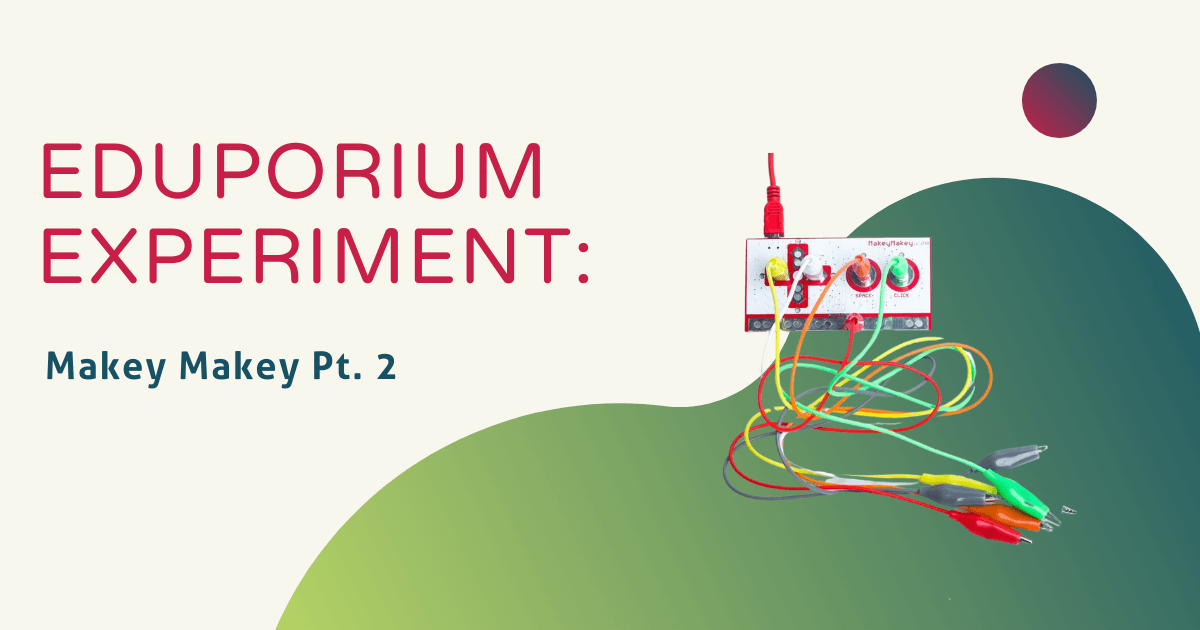The Makey Makey, created by the JoyLabz team, is one of the most well-known STEAM tools in K-12 education. What exactly is it, though?? Technically, the Makey Makey works like any keyboard or mouse, sending signals to a computer to execute the functions of clicking the mouse or hitting the space bar, right arrow, left arrow, up arrow, or down arrow. When users close a circuit using the alligator clips and a conductive object, the signal is sent to the computer, just as if a button was pressed on the keyboard or mouse.
Not only can kids find super creative ways to test conductivity using the Makey Makey, but they can also try programing by using the back of the board. For example, the connector wires can connect the board to LEDs and motors that students can control using the Makey Makey and a programming environment, such as Scratch.

In the box, there’s everything kids could possibly need to get started with fun experimentation, including the Makey Makey board itself, a USB cable, seven alligator clips, six connector wires, 20 stickers, and a very helpful instruction guide. All they have to do is gather some objects they want to test for conductivity and they’re ready to go! First, I plugged the USB cable into the Makey Makey board and the other end into my laptop, which gave the Makey Makey power. I then used the alligator clips to clip one end to the holes on the front of the board, including the “earth” section to make sure I grounded myself before attaching one to the space, click, and arrow slots as well. Then, I attached the other end of each clip to various items I had around me.
To test their conductivity, I pulled up the Makey Makey piano on my laptop. When the Makey Makey is connected to a computer or laptop and the alligator clips are connected to both the board and an external object, the piano will play if that external object is conductive because people have conductivity inside of them, meaning that they can complete the circuit when they hold the grounded wire in their hand. When I held the grounded alligator clip, I was able to tap the other connected items to see if they would play the keys of the piano.
I tested a quarter, a plant, and a cup of water from the sink in our office. I expected all to be conductive, but discovered that only the quarter and the water would get the piano to play (I think the plant was too dry)! It was super fun to try various items, though, and the educational experience was like no other tech tool. There are even rumors that not all water is conductive, so if you have the chance try the Makey Makey with both distilled and non-distilled water, go for it and see what happens!

The educational activities with Makey Makey are certainly not limited to testing conductivity, however. Students can use the connector wires with the back of the board to learn programming! The Makey Makey is a true K-12 STEAM tool that involves crafting, exploration, and hands-on experimentation if educators implement it properly. Students can learn all about circuits, electricity, conductivity, and even coding!
Most importantly, the Makey Makey team offers supportive educator guides and sample lesson plans online as well as additional support for teachers through their Makey Makey Labz system, which allows teachers to assign projects, keep track of progress, and find example activities and projects for inspiration. They also offer workshops for educators and trainers looking to bolster their Makey Makey skills to ensure they are fully prepared to use it to its highest potential.
To purchase a Makey Makey or STEM Pack for your classroom, makerspace, or home, click below to visit the Eduporium store. Don't forget to follow us on Twitter and Instagram for more, check out other cool EdTech tools in our store, and you might as well like us on Facebook, too!





